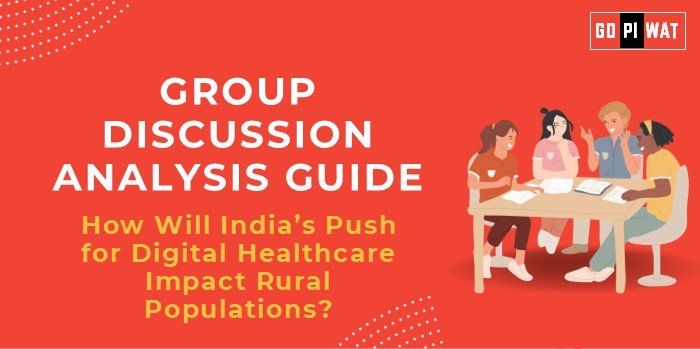📋 Group Discussion (GD) Analysis Guide
📝 Topic: How Will India’s Push for Digital Healthcare Impact Rural Populations?
🌐 Introduction
🌏 Opening Context: India’s efforts in digital healthcare aim to transform rural health services by improving accessibility, affordability, and efficiency. With a large rural population still struggling with healthcare gaps, these initiatives are crucial for inclusive development.
📜 Topic Background: Initiatives like the Ayushman Bharat Digital Mission (ABDM) and e-Sanjeevani telemedicine services demonstrate India’s push to bridge healthcare disparities. Despite notable advancements, challenges like digital literacy and infrastructure deficits persist.
📊 Quick Facts and Key Statistics
- 🏥 Ayushman Bharat Beneficiaries: 30,529 hospitals empanelled under PM-JAY as of September 2024, including 17,063 public and 13,466 private facilities.
- 📞 Teleconsultations via e-Sanjeevani: Over 80 million teleconsultations achieved by December 2022, with 57% of beneficiaries being women.
- 📡 Internet Penetration in Rural Areas: 42% of India’s internet subscribers (398.35 million) reside in rural areas as of March 2024.
- 👩⚕️ Healthcare Workforce Gap: In 2022, an 80% shortage of specialist doctors in rural Community Health Centres (CHCs) underscored systemic challenges.
🎯 Stakeholders and Their Roles
- 🏛️ Government: Policy formulation, infrastructure development (e.g., BharatNet), and funding digital health programs.
- 💼 Private Sector: Providing tech solutions like telemedicine platforms and AI-based diagnostics.
- 🤝 NGOs and Health Workers: Bridging the last-mile gap in awareness and access.
- 🌍 International Agencies: Funding and offering global best practices for digital health.
🏆 Achievements and Challenges
🔑 Achievements
- 📈 Expanded Hospital Network: Ayushman Bharat includes over 30,000 hospitals, making healthcare more accessible to rural populations.
- 👩⚕️ Empowered Women: Over 57% of teleconsultation beneficiaries via e-Sanjeevani were women, promoting gender equity in healthcare access.
- 📡 Improved Internet Penetration: With 42% rural internet users, digital health initiatives now have a broader reach.
⚠️ Challenges
- 👩⚕️ Workforce Shortages: An 80% shortage of specialist doctors in rural CHCs impedes effective healthcare delivery.
- 📉 Infrastructure Gaps: Internet connectivity and power supply remain inconsistent in remote areas.
- 🔒 Cybersecurity Risks: Increasing digitization amplifies data breach concerns.
🌍 Global Comparisons
- 🇪🇪 Estonia: A leader in digital health, integrating e-health records for its entire population.
- 🇰🇪 Kenya: Successfully utilized mobile-based healthcare systems to expand rural access.
💡 Effective Discussion Approaches
🌟 Opening Approaches
- 📊 “With over 80 million teleconsultations, e-Sanjeevani has significantly enhanced healthcare delivery in rural areas.”
- ⚖️ “Despite Ayushman Bharat’s extensive hospital network, workforce shortages remain a critical challenge.”
🎯 Counter-Argument Handling
- 📡 Acknowledge rural internet gaps but highlight emerging solutions like mobile health platforms.
- 📋 Address workforce shortages by proposing tele-specialist programs and online training modules.
📊 Strategic Analysis of Strengths & Weaknesses
🔍 SWOT Analysis
- 💪 Strengths: Empanelled hospitals, teleconsultation success, rising rural internet penetration.
- 📉 Weaknesses: Doctor shortages, infrastructure gaps, and low digital literacy in rural areas.
- 🌟 Opportunities: AI for diagnostics, mobile health solutions, and public-private partnerships.
- ⚠️ Threats: Cybersecurity vulnerabilities and uneven implementation.
🗣️ Structured Arguments for Discussion
- ✅ Supporting Stance: “India’s digital healthcare initiatives significantly reduce the urban-rural healthcare gap, especially for women.”
- ❌ Opposing Stance: “Without resolving workforce and infrastructure issues, digital healthcare alone cannot solve rural health challenges.”
- ⚖️ Balanced Perspective: “While digital healthcare is transformative, addressing systemic bottlenecks is equally critical.”
📚 Connecting with B-School Applications
- 🧠 Real-World Applications: Research on health-tech scalability, rural healthcare models, and public policy.
- 📋 Sample Interview Questions:
- 🤔 “How can AI optimize rural healthcare delivery in India?”
- 📡 “What role do private companies play in India’s digital health revolution?”
- 💡 Insights for Students: Opportunities to explore scalable solutions, cybersecurity frameworks, and rural health economics.


